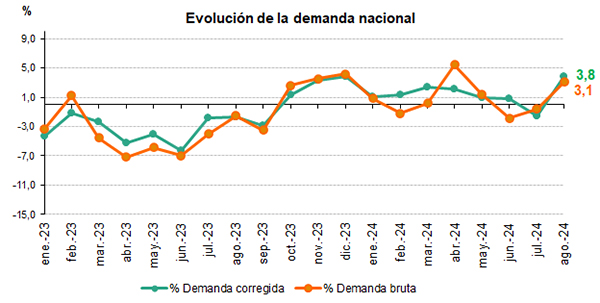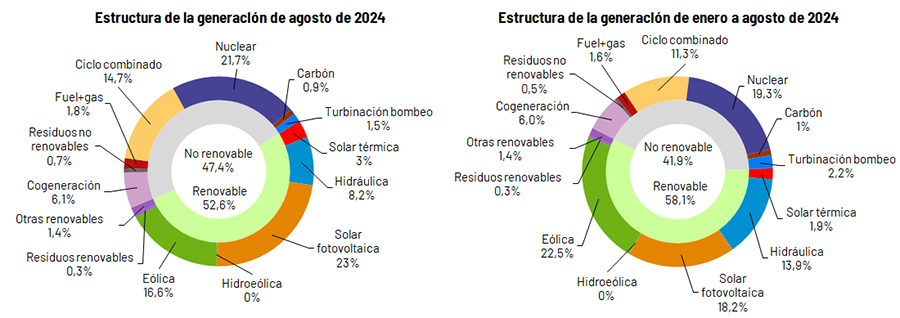Demand for electric energy in Spain increases by 3.8% in August. For the fourth consecutive month, solar photovoltaics leads the national generation mix with 23% of the total. Wind energy generated 16.6%. Monthly production with renewables in our country accounted for 52.6% and technologies that do not emit CO2 equivalent reached a share of 75.4%.
National electricity demand experienced an increase of 3.8% in August compared to the same month of the previous year, once the effects of temperature and work have been discounted. In gross terms, demand is estimated at 22,347 GWh, 3.1% more than in August 2023. Monthly evolution of demand From January to August 2024, Spain has recorded a cumulative demand of 165,806 GWh, 0.8% more than in the same period in 2023. Once the effects of working hours and temperatures have been taken into account, demand is growing by 1.3% compared to the same period of the previous year.

This month, renewables generated 12,341 GWh, 13.6% more than in August 2023, and reached a share of 52.6% of the total, this being the fourth consecutive month in which solar photovoltaics leads the national mix, with 23% of the total. During this month, this technology produced 5,400 GWh, which is 20.8% more than in August 2023. According to the provisional data available today, photovoltaics were followed by nuclear (21.7%) and wind (16.6%) as the technologies with the highest production in August.
With this boost from renewables, 75.4% of the electricity produced in Spain during the month of August 2024 was free of CO2 equivalent emissions.
Generation structure in August and in 2024. Peninsular demand increases by 3.9% At the peninsular level and once the effects of work and temperature have been taken into account, demand has been 3.9% higher than in August 2023 In gross terms, demand for this month has been 20,776 GWh, 3.2% higher than in the same month of the previous year.
In the cumulative period from January to August this year, peninsular demand was 155,590 GWh, 0.9% higher than that recorded in 2023. Once the effects of working hours and temperatures have been taken into account, peninsular demand grew by 1.3% compared to the same period of the previous year.

The set of peninsular renewables generated 54.4% of the total in August, according to the provisional data available today, which show a production of 12,015 GWh, 13.5% more than in the same month of the previous year. For their part, emission-free technologies contributed 78.7% of the total.
The peninsular generation structure in August is also led by solar photovoltaic, which has been responsible for 24.1% of the total by producing 5,309 GWh during this month, 20.9% more than in August 2023. The electrical system in the Balearic and Canary Islands In the Balearic Islands, electricity demand in August has been 3.5% higher than in the same month of 2023, once the effects of working hours and temperatures have been taken into account. Thus, gross demand is estimated at 735,905 MWh, 4.4% higher than in August of the previous year. From January to August 2024, gross demand in the Balearic Islands is estimated at 4,138,923 MWh, 0.3% less than in the same period in 2023. In terms of generation, the combined cycle, with 64.2% of the energy produced in the Balearic Islands, was the main source of energy for the islands this month. For its part, renewable energy and the equivalent CO2 emissions generated in the Balearic community represented 13.1% of the total. Renewable production in the Balearic Islands grew by 21% in August compared to the same month of the previous year.
In addition, during this month of August, the submarine link between the Peninsula and Mallorca contributed to covering 25.4% of the Balearic electricity demand.
For its part, in the Canary Islands, the demand for electricity increased by 0.4% compared to the same month in 2023, taking into account the effects of work and temperatures. In gross terms, demand was 791,977 MWh, 1.3% less. In the first eight months of 2024, the Canary Islands’ demand is estimated at 5,813,443 MWh, 1.3% more than in the same period of 2023. As for electricity generation in the Canary Islands, the combined cycle, with 34.6% of the total, was also the main source in August. Renewables and emission-free technologies reached a share of 32.1% of production by generating 254,015 MWh, the highest amount recorded in the archipelago. For its part, the contribution of wind power during this month has been 27% of the total, reaching a growth of 19.8% compared to its production in August 2023.


